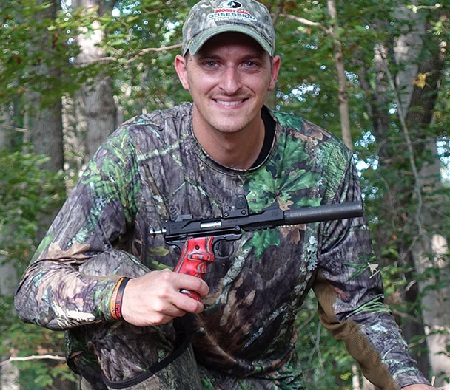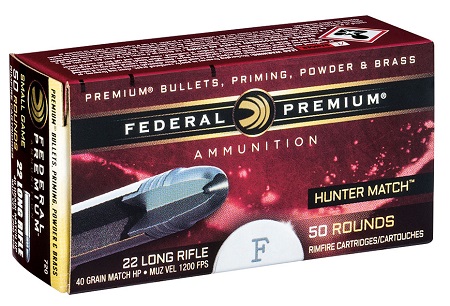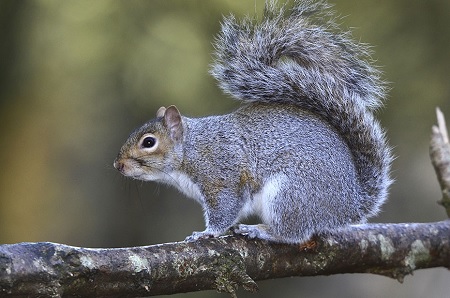
Thanks to their proportions, squirrels can be challenging to bring down—particularly when you’re armed with a rimfire rifle or handgun and not a shotgun. Federal Premium’s trick-shooting YouTube superstar and lifelong squirrel hunter 22plinkster reveals his secrets for hitting bushytails and other small game. (22plinkster channel – https://www.youtube.com/channel/UC5lvNBwPlYDB-9-uQoY2jIg)
Gear Up
The road to success begins long before you ever set foot in the squirrel woods. “Start by gearing up with a straight-shooting firearm, outfitted with a scope, and the right ammunition for the job,” says 22plinkster, who goes by the stage name Dave Nash and prefers to keep his true identity confidential.
“The good news is, squirrel hunting is an extremely affordable sport,” he continues. “You can pick up a good, accurate .22 for under $200. A decent small game optic will add another 50 to 75 bucks, and is a vast improvement over iron sights. You’ll get more game. But more importantly, as an ethical hunter, you owe it to whatever you’re shooting to make a clean kill, and a scope helps you do that.”
Nash also recommends adding a suppressor to the rifle. “You’ll shoot tighter groups,” he says. “Plus, silenced reports spook less game, so you get more follow-up shots on other squirrels in the area. It’s also easier to hear the bullet’s impact, which makes a distinctive sound when hitting a squirrel compared to a tree or the ground. If you pay attention, you can actually hear whether you hit or missed.”
“Hollow-point loads have greater expansion and shocking power than standard solid, round-nosed bullets.”
 Accurate, hollow-point lead or jacketed bullets get the nod in the ammo department. “Accuracy is paramount,” he says. “Hollow-point loads have greater expansion and shocking power than standard solid, round-nosed bullets.”
Accurate, hollow-point lead or jacketed bullets get the nod in the ammo department. “Accuracy is paramount,” he says. “Hollow-point loads have greater expansion and shocking power than standard solid, round-nosed bullets.”
Nash’s personal favorite is Federal Premium’s new Hunter Match 22 LR. “I was lucky enough to get some engineering samples before the ammunition was released on the market, so I’ve been shooting it for about a year now,” he says. “In that time, I’ve found that Hunter Match is extremely accurate out to 100 yards. With the right scope and rifle you can achieve 1- to 1¼-inch groups at that range. It also has a flat trajectory, which takes the guesswork out of where to hold.”
Whatever ammunition you choose, don’t skimp on it. “If you get into a mess of squirrels, you might fire 50 or 60 times in one sitting,” he says. “I usually have two or three detachable magazines in one pocket and a handful of loose rounds in another.”
Practice Makes Perfect
Nash advises honing your shooting skills at the range, not while hunting. “Practice is critical,” he says. “But first, zero in your rifle on the bench. You need to know where it’s shooting, because being off by even an inch or two at 50 yards will make a big difference when small game hunting.”
“Being off by even an inch or two at 50 yards will make a big difference.”
Once sighted in, it’s time to practice. Paper and metal silhouette targets are great options, but Nash also likes to add real-world situations to the drill. “While sitting with my back to a tree, like I generally do while squirrel hunting, I shoot golf balls scattered at distances from 25 to 100 yards away,” he says. “The great thing about a golf ball is, you instantly know whether you hit or missed, and the ball repositions itself after a hit.”
Choose Your Shots
Nash can split playing cards and make other ridiculously hard shots look easy, but even he holds his fire in certain situations.
“There are two shots I won’t take,” he says. “The first is anything over 100 yards. I know my rifle shoots 1-inch groups at that range, and I’m confident and capable of cleanly taking small game up to that point. I won’t risk wounding an animal by pushing the envelope.”
Nash’s second no-go is a shot lacking a solid backstop. “I never shoot at a squirrel silhouetted in a treetop, because if I miss, the bullet can go 1½ miles and hit a person, building or livestock,” he says. “Always make sure the tree trunk or the ground is behind your target.”
When a safe backstop is in play, Nash still recommends being picky about shot selection. “Shots at calm, stationary animals are ideal,” he says. “I usually aim for the head, because the animal will drop instantly. And I won’t shoot anywhere farther back than the front shoulders. Bottom line, if you can’t see the head, front shoulders and heart section, wait until the squirrel presents a better shot.”
It’s worth noting Nash compulsively rests his rifle on his knee, a tree or other solid object whenever possible. “I won’t take freehand shots at squirrels beyond about 35 yards,” he says.
 Hunt Smart
Hunt Smart
It’s tempting to cover ground by marching through the forest, but Nash says you’ll see—and shoot—more squirrels by taking a stand.
“Find an oak or hickory grove that offers plenty of food and a few good den trees, choose a spot with a good view of the surrounding area, then sit down, hold still and wait for the squirrels to start moving again,” he says.
“Don’t fidget around or get up and move after a couple of minutes,” he adds. “It may take 20 minutes for the squirrels to resume their normal activities.”
“Squirrel hunting is pretty much a lost art … That’s a shame, because it makes you a better hunter, and it’s a whole lot of fun.”
After shooting a squirrel, Nash resists the temptation to add it to his game bag. “I keep sitting,” he says. “If you get up and move, you’ll spook the rest of the squirrels. By holding still, you often have a chance to take multiple animals from one location. Make a mental note of where each squirrel drops and pick them up when you’re ready to leave.”
Share The Experience
A diehard squirrel hunter, Nash laments the decline in the sport’s popularity. “Squirrel hunting is pretty much a lost art for anyone under 35,” he says. “That’s a shame, because it makes you a better hunter, and it’s a whole lot of fun. If you get a chance to introduce someone to the sport, take it.”
